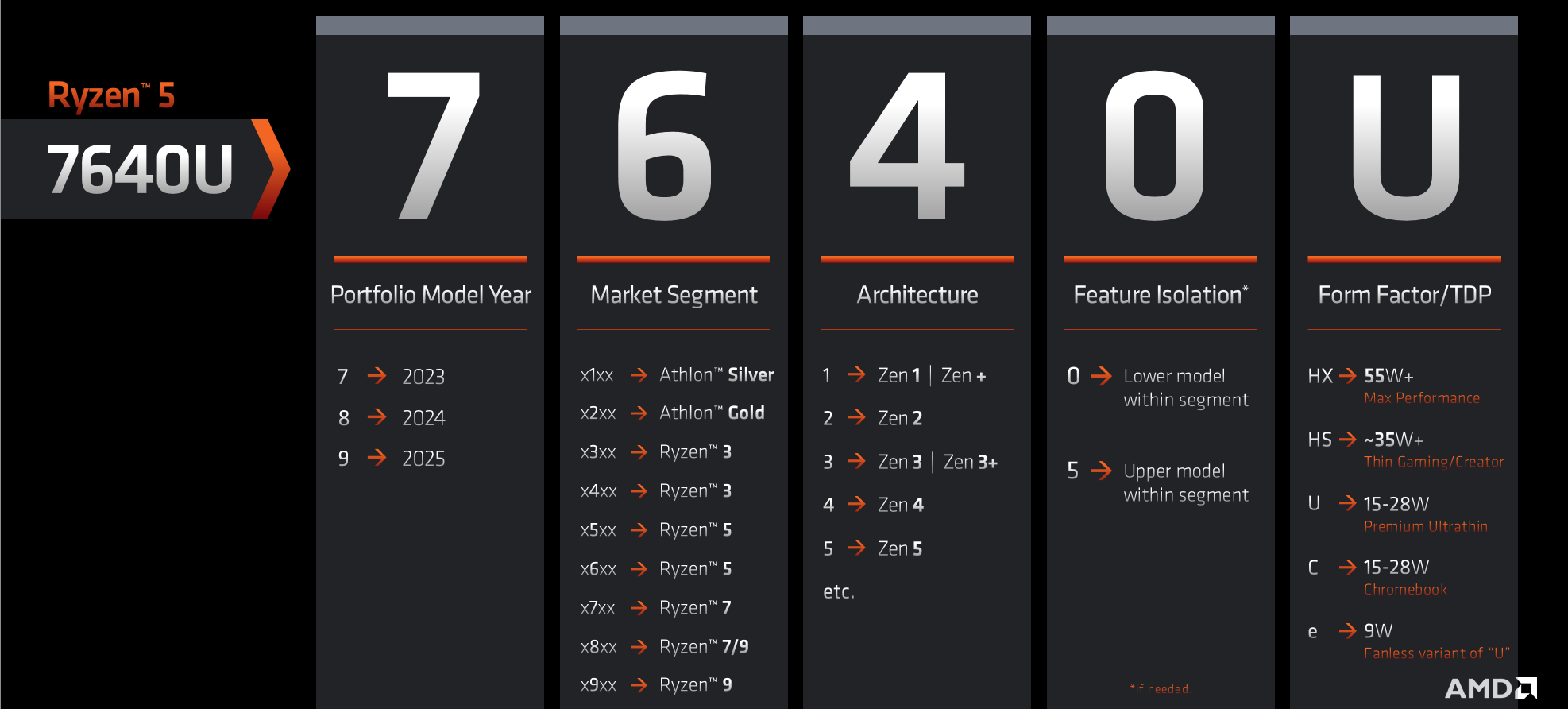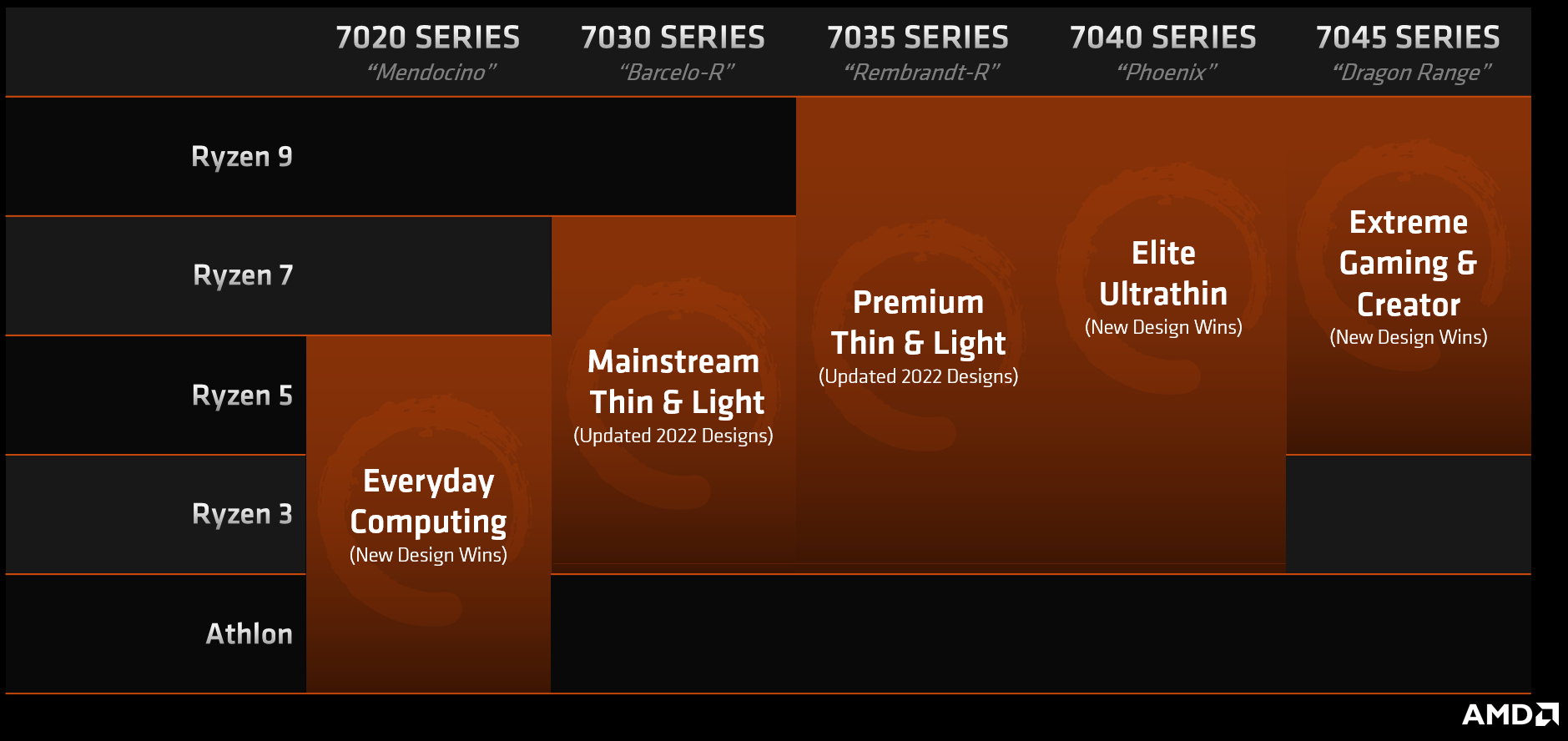Quick Links
Key Takeaways
- The first number in the model name represents the release year, not performance.
- The second number indicates the market segment and the performance level of the CPU, with higher numbers typically indicating better performance.
- The third number now denotes the architecture; a higher number means a newer and better architecture.
AMD has completely changed its naming scheme for laptop CPUs with the release of the 7000 Series. Their laptop CPU names are now quite different from their desktop counterparts. Let’s break down their naming scheme and explain what each number means for you.
How to Read and Understand AMD Laptop CPU Names
This handy chart with the example number “7640U” gives you some information on how to read model numbers. If you care about performance, pay close attention to the second and third digits. Still, it’s hard to comprehend these perplexing model numbers without any context. Let’s go through them one by one.
Portfolio Model Year
Traditionally, the first number in CPUs has been the CPU generation. The series model number used to be tied in with the architecture, so a newer processor would typically be more powerful than its predecessor.
But that’s no longer the case. The first number now only represents the release year and has little to do with performance. Enthusiasts on Reddit called out AMD because of this, claiming that branding an older architecture under a newer portfolio model year is an anti-consumer move. This is because AMD can now sell a processor with an older architecture as a brand-new model to uninformed buyers. Whatever the case might be, the fact is that the first number no longer tells us anything meaningful about performance.
Market Segment
The second number is mostly tied to the “primary” model name; it tells you whether it’s an Athlon Silver/Gold (for budget laptops) or a Ryzen 3/5/7/9 CPU. Here’s a quick visual representation of the market segment and architecture in relation to the processor’s intended use.
It’s one of the most important factors for performance; a CPU in a higher market segment typically has more cores or is faster than the one below it.
Confusingly, the market segment digit doesn’t strictly correspond to the primary model name. For example, both three and four can indicate a Ryzen 3 CPU. Pay especially close attention to the number 8, as it can indicate both a Ryzen 7 or a Ryzen 9 CPU.
Architecture
The microarchitecture of a processor is the design and organization that dictates how a CPU operates. Usually, a newer architecture is more powerful and efficient, and it often has a smaller transistor size as well. A newer architecture brings a significant performance increase compared to its predecessor. A newer architecture also typically requires less power, resulting in increased battery life.
The third number tells us the CPU architecture, which matches the AMD “Zen” core architecture—one indicates the Zen 1 architecture, two is for Zen 2, etc. When you’re buying a new laptop, this is one of the most important numbers to pay attention to.
As I mentioned earlier, architectures were traditionally tied in with the CPU series. Now you have to be vigilant by carefully examining the architecture digit to get an idea of the CPU’s power and efficiency.
Feature Isolation
Feature isolation helps you further differentiate between two different architectures that aren’t indicated in the architecture number. It’s always a zero or a five, with the five indicating a better model. For example, you can use it to differentiate between a Zen 3 and Zen 3+ CPU, as the plus model will have a 5. It may also indicate that the CPU has smaller, more efficient “C” cores, which AMD claims perform at the same level as their non-C counterparts.
Form Factor/TDP
The last part of the model name is actually a letter suffix, somewhat similar to those found in Intel CPUs. It tells you the CPU’s intended use, and it’s tied in with Thermal Design Power (TDP). Essentially, a CPU with a higher TDP consumes more electricity to operate. The HX designation indicates the most powerful CPUs, but these chips also have the highest TDP of 55W or more. A CPU with a higher TDP gets hotter and can have a shorter battery life. Still, the suffix won’t mean much to you, as it’s primarily tied in with the rest of the CPU model name.
Don’t Let the Model Year and Architecture Trick You
Unfortunately, you can no longer rely on the first number alone when comparing old versus new AMD CPUs; you have to check the architecture instead. We now need to keep a close eye when shopping for a new AMD-powered laptop to avoid being misled by the portfolio model year. I believe that the discrepancy is a calculated move, as it allows AMD to rebadge last year’s CPUs as a new model.
source

